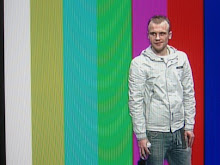Gyorgy Kepes: Hungarian-born painter, author, designer, author and educator. After immigrating to the US in 1937 he taught design at the New Bauhaus where he taught designers such as Saul Bass. Kepes was interested in unifying both art and science. His thought and work embraced both nature and technology.
Kepes’ art is avant-garde and kinetic ranging from abstract painting to photography, photo-design and exhibition design to large kinetic objects, systems and environmental/ecological organisms.

Whispering Signals (1972)
Oil on Canvas
One Integrated Flow of Production, from the Early Series, 1938
Gelatin silver print, gouache, and airbrush on paperboard
I am particularly interested in his photography work. Kepes used light as a creative medium and had a lifelong fascination with optical psychics, through photography, at first portraying them and then an investigation of their mechanics. He had always been devoted to examining the nature of light working with the concept of symmetry, balance and rhythm. His images are mysterious, otherworldly with abstract depths and forms that were created via experiments with light sensitive paper.

Untitled Abstraction

The Two Faces o Juliet

Juiet

“There is an age-old dialogue between man and light… Our human nature is profoundly phototropic. Men obey their deepest instincts when they hold fast to light in comprehensive acts of perception and understanding through which they learn about the world, orient themselves within it, experience the joy of living, and achieve a metaphoric, symbolic grasp of life.”
Kepes believed that light was an essential tool in art and that ‘Artists afraid of light and the meaning of light.’
“In all major cities of the world, the ebbing of the day brings a second world of light…It is the world of man-made light sources, the glittering dynamic glow of artificial illumination of the twentieth-century metropolis…Washing away the boundary between night and day has lost us our sense of connection with nature and its rhythms. If our artificial illumination is bright and ample, it is without the vitality, the wonderful ever-changing quality of natural light. For the warm, living play of firelight we have substituted the bluish, greenish television screen with its deadening stream of inane images…”






No comments:
Post a Comment